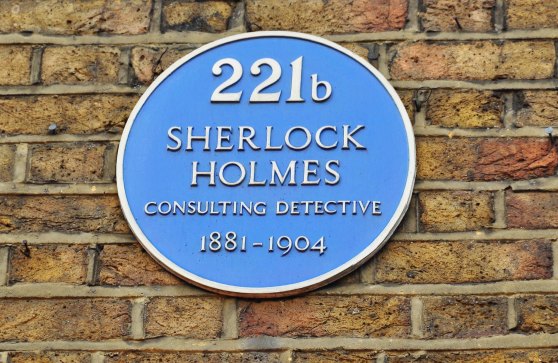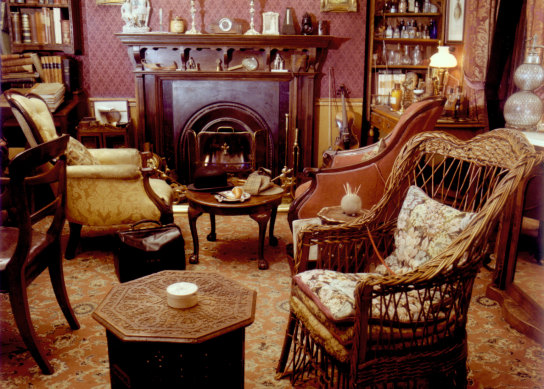
There’s a queue outside the door of the world’s most famous address, 221B Baker Street, London. Are they waiting to consult the brilliant detective? No, like me, they are tourists on a literary pilgrimage, hoping to see “The Official Home of Sherlock Holmes”.
You have to queue because it’s a house of small rooms on several floors, with steep narrow staircases, so they can only let in a few people at a time. A guide in Victorian costume shows us around. Every room is a cosy clutter, packed with Victorian knick-knacks and memorabilia from the supersleuth’s most celebrated cases. Portraits of gentlemen covering one wall turn out to be photographs of notorious 19th-century murderers.

One of London’s famous blue plaques on the building where the fictional Sherlock Holmes lived in Sir Arthur Conan Doyle’s books.Credit: Vladislav Zolotov
I spot The Severed Thumb of Mr Victor Hatherley, the Mask and Gloves of Lucy Hebron, The Voodoo Fetish from the House of Mr Garcia, found Murdered on Oxshott Common, and bullet holes on the wall that spell out the initials VR. Congratulations if you can name which stories they all come from.
The crowded gift shop next door is bigger than the house itself and offers delights such as magnifying glasses, pipes, music boxes and deerstalker hats for your dog or cat.
In the city, not far away, I find another museum, the house of a real literary celebrity, Dr Samuel Johnson. It’s a five-storey townhouse in a small square dwarfed by surrounding office towers – I almost miss it. There are few visitors, no queues, no guides, no tourist razzmatazz.
Dr Johnson lived here for seven years with his servant Francis Barber, his lodger Anna Williams and a succession of cats. He entertained many friends in the parlour, which was painted dark brown so the soot from the London smog wouldn’t show.

Sherlock Holmes’ study at 221b Baker Street.Credit: © The Sherlock Holmes Museum. www.sherlock-holmes.co.uk
Each room is furnished in 18th-century style, with fascinating bits of information. The best room is the garret, large and bright, and here’s the desk and chair where Dr Johnson sat with his team of helpers composing his masterwork, A Dictionary of the English Language. Dr Johnson was ahead of his time in valuing highly intelligent women. I learn that Williams, one of his friends, lodged with him for 30 years. Sadly, she went blind and refused to meekly bear her fate. She would fly into paroxysms of rage.
My third literary pilgrimage is to Alfred, Lord Tennyson’s house, Farringford, on the Isle of Wight, a very different and carefully curated experience. It’s a beautifully restored and furnished mansion, with battlements like a castle, extensive grounds and a gorgeous garden. You have to book ahead, there are guides in every room and audio tour commentary. Tennyson came here with his family to write and to get away from his fans, though he didn’t always succeed: they were apt to show up with their noses pressed against the windows and they had the effrontery to pick his flowers.









 Add Category
Add Category